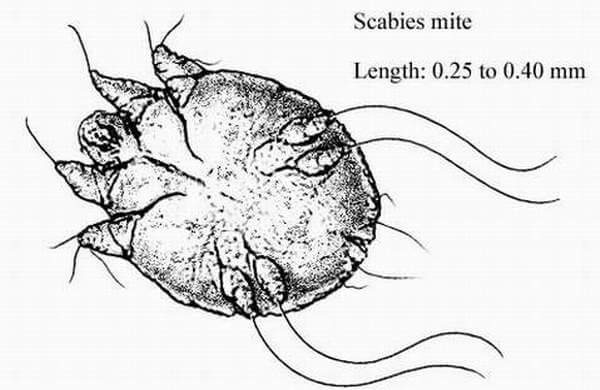What's in this article?
Scabies Introduction
Scabies is a contagious ectoparasite skin condition caused by the mite Sarcoptes scabiei var. hominis (No relation to lice). In this condition, mites burrow into human skin and lay their eggs, which later hatch and grow into adults. The characteristic symptoms of this condition include superficial burrows, intense pruritus (itching) and secondary infection.
Illustration copyright 2000 by Nucleus Communications, Inc. All rights reserved. http://www.nucleusinc.com
Scabies mites burrow into the outer layers of human skin, causing itching, a rash, and sometimes skin sores. The scabies mites are spread through close contact with an infested person, such as by touching or by sleeping in the same bed.
History of Discovery
Scabies is an ancient disease. Based on archeological evidence from Egypt and the Middle East, scabies is estimated to date back over 2,500 years (Markell & Voge). The first recorded reference to scabies is believed to be from the Bible (Leviticus, the third book of Moses) ca. 1200 BCE. Later, the Roman philosopher Aristotle reported on “lice” that would “escape from little pimples if they are pricked” in the fourth century BCE (Roncalli); scholars believe this was actually a reference to scabies.
Nevertheless, it was the Roman physician Celsus who is credited with designating the term “scabies” to the disease and describing its characteristic features (Roncalli). The parasitic etiology of scabies was later documented by the Italian physician Giovanni Cosimo Bonomo (1663-1969 ADE) in his famous 1687 letter, “Observations concerning the fleshworms of the human body” (Roncalli). With this (disputed) discovering, scabies became one of the first diseases with a known cause (Markell & Voge).
Mode of Transmission
The majority of scabies cases are transmitted by skin-to-skin contact with persons carrying the scabies mite. Less often, scabies can be transmitted by sharing of clothes and bedding. Theoretically, touching an object that a mite is on is a third mode of transmission; however, this is not at all common.
Incubation Period
Upon infection, adult mites dig into the upper layers of human skin, creating burrows. Eggs are deposited into the burrows and hatch as larvae 3 to 4 days later. The larvae then excavate new burrows and mature in approximately 4 days (Markell & Voge). Once infected, the scabies lifecycle will continue until medication is used to treat the disease.
The associated skin disease characteristic of scabies develops due to delayed immune system hypersensitivity. The incubation period for this itching and rash is usually 2-6 weeks. However, in individuals with prior exposure to scabies, the incubation period is much shorter: as little as 1 to 4 days (Markell & Voge).





